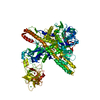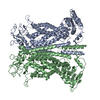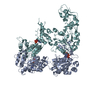+ Open data
Open data
- Basic information
Basic information
| Entry | Database: PDB / ID: 7r88 | ||||||||||||
|---|---|---|---|---|---|---|---|---|---|---|---|---|---|
| Title | The structure of human ABCG5-I529W/ABCG8-WT | ||||||||||||
 Components Components |
| ||||||||||||
 Keywords Keywords | LIPID TRANSPORT/IMMUNE SYSTEM /  sterol / sterol /  lipids / lipids /  ABC transporter / LIPID TRANSPORT / LIPID TRANSPORT-IMMUNE SYSTEM complex ABC transporter / LIPID TRANSPORT / LIPID TRANSPORT-IMMUNE SYSTEM complex | ||||||||||||
| Function / homology |  Function and homology information Function and homology informationnegative regulation of intestinal phytosterol absorption / negative regulation of intestinal cholesterol absorption / Defective ABCG8 causes GBD4 and sitosterolemia / Defective ABCG5 causes sitosterolemia / sterol transport /  ABC transporters in lipid homeostasis / intestinal cholesterol absorption / cholesterol transfer activity / triglyceride homeostasis / phospholipid transport ...negative regulation of intestinal phytosterol absorption / negative regulation of intestinal cholesterol absorption / Defective ABCG8 causes GBD4 and sitosterolemia / Defective ABCG5 causes sitosterolemia / sterol transport / ABC transporters in lipid homeostasis / intestinal cholesterol absorption / cholesterol transfer activity / triglyceride homeostasis / phospholipid transport ...negative regulation of intestinal phytosterol absorption / negative regulation of intestinal cholesterol absorption / Defective ABCG8 causes GBD4 and sitosterolemia / Defective ABCG5 causes sitosterolemia / sterol transport /  ABC transporters in lipid homeostasis / intestinal cholesterol absorption / cholesterol transfer activity / triglyceride homeostasis / phospholipid transport / Translocases; Catalysing the translocation of other compounds; Linked to the hydrolysis of a nucleoside triphosphate / cholesterol efflux / response to muscle activity / bile acid signaling pathway / response to ionizing radiation / ATPase-coupled transmembrane transporter activity / ABC-type transporter activity / NR1H3 & NR1H2 regulate gene expression linked to cholesterol transport and efflux / ATP-binding cassette (ABC) transporter complex / response to nutrient / cholesterol homeostasis / transmembrane transport / ABC transporters in lipid homeostasis / intestinal cholesterol absorption / cholesterol transfer activity / triglyceride homeostasis / phospholipid transport / Translocases; Catalysing the translocation of other compounds; Linked to the hydrolysis of a nucleoside triphosphate / cholesterol efflux / response to muscle activity / bile acid signaling pathway / response to ionizing radiation / ATPase-coupled transmembrane transporter activity / ABC-type transporter activity / NR1H3 & NR1H2 regulate gene expression linked to cholesterol transport and efflux / ATP-binding cassette (ABC) transporter complex / response to nutrient / cholesterol homeostasis / transmembrane transport /  receptor complex / response to xenobiotic stimulus / apical plasma membrane / protein heterodimerization activity / receptor complex / response to xenobiotic stimulus / apical plasma membrane / protein heterodimerization activity /  ATP hydrolysis activity / ATP hydrolysis activity /  ATP binding / ATP binding /  metal ion binding / metal ion binding /  plasma membrane plasma membraneSimilarity search - Function | ||||||||||||
| Biological species |   Homo sapiens (human) Homo sapiens (human)  Mus musculus (house mouse) Mus musculus (house mouse) | ||||||||||||
| Method |  ELECTRON MICROSCOPY / ELECTRON MICROSCOPY /  single particle reconstruction / single particle reconstruction /  cryo EM / Resolution: 3.5 Å cryo EM / Resolution: 3.5 Å | ||||||||||||
 Authors Authors | Sun, Y. / Li, X. / Long, T. | ||||||||||||
| Funding support |  United States, 3items United States, 3items
| ||||||||||||
 Citation Citation |  Journal: Proc Natl Acad Sci U S A / Year: 2021 Journal: Proc Natl Acad Sci U S A / Year: 2021Title: Molecular basis of cholesterol efflux via ABCG subfamily transporters. Authors: Yingyuan Sun / Jin Wang / Tao Long / Xiaofeng Qi / Linda Donnelly / Nadia Elghobashi-Meinhardt / Leticia Esparza / Jonathan C Cohen / Xiao-Song Xie / Helen H Hobbs / Xiaochun Li /   Abstract: The ABCG1 homodimer (G1) and ABCG5-ABCG8 heterodimer (G5G8), two members of the adenosine triphosphate (ATP)-binding cassette (ABC) transporter G family, are required for maintenance of cellular ...The ABCG1 homodimer (G1) and ABCG5-ABCG8 heterodimer (G5G8), two members of the adenosine triphosphate (ATP)-binding cassette (ABC) transporter G family, are required for maintenance of cellular cholesterol levels. G5G8 mediates secretion of neutral sterols into bile and the gut lumen, whereas G1 transports cholesterol from macrophages to high-density lipoproteins (HDLs). The mechanisms used by G5G8 and G1 to recognize and export sterols remain unclear. Here, we report cryoelectron microscopy (cryo-EM) structures of human G5G8 in sterol-bound and human G1 in cholesterol- and ATP-bound states. Both transporters have a sterol-binding site that is accessible from the cytosolic leaflet. A second site is present midway through the transmembrane domains of G5G8. The Walker A motif of G8 adopts a unique conformation that accounts for the marked asymmetry in ATPase activities between the two nucleotide-binding sites of G5G8. These structures, along with functional validation studies, provide a mechanistic framework for understanding cholesterol efflux via ABC transporters. | ||||||||||||
| History |
|
- Structure visualization
Structure visualization
| Movie |
 Movie viewer Movie viewer |
|---|---|
| Structure viewer | Molecule:  Molmil Molmil Jmol/JSmol Jmol/JSmol |
- Downloads & links
Downloads & links
- Download
Download
| PDBx/mmCIF format |  7r88.cif.gz 7r88.cif.gz | 250.7 KB | Display |  PDBx/mmCIF format PDBx/mmCIF format |
|---|---|---|---|---|
| PDB format |  pdb7r88.ent.gz pdb7r88.ent.gz | 201.4 KB | Display |  PDB format PDB format |
| PDBx/mmJSON format |  7r88.json.gz 7r88.json.gz | Tree view |  PDBx/mmJSON format PDBx/mmJSON format | |
| Others |  Other downloads Other downloads |
-Validation report
| Arichive directory |  https://data.pdbj.org/pub/pdb/validation_reports/r8/7r88 https://data.pdbj.org/pub/pdb/validation_reports/r8/7r88 ftp://data.pdbj.org/pub/pdb/validation_reports/r8/7r88 ftp://data.pdbj.org/pub/pdb/validation_reports/r8/7r88 | HTTPS FTP |
|---|
-Related structure data
| Related structure data |  24311MC  7r87C  7r89C  7r8aC  7r8bC  7r8cC  7r8dC  7r8eC M: map data used to model this data C: citing same article ( |
|---|---|
| Similar structure data |
- Links
Links
- Assembly
Assembly
| Deposited unit | 
|
|---|---|
| 1 |
|
- Components
Components
| #1: Protein | Mass: 74510.438 Da / Num. of mol.: 1 / Mutation: I529W Source method: isolated from a genetically manipulated source Source: (gene. exp.)   Homo sapiens (human) / Gene: ABCG5 / Production host: Homo sapiens (human) / Gene: ABCG5 / Production host:   Homo sapiens (human) Homo sapiens (human)References: UniProt: Q9H222, Translocases; Catalysing the translocation of other compounds; Linked to the hydrolysis of a nucleoside triphosphate |
|---|---|
| #2: Protein | Mass: 80365.828 Da / Num. of mol.: 1 Source method: isolated from a genetically manipulated source Source: (gene. exp.)   Homo sapiens (human) / Gene: ABCG8 / Production host: Homo sapiens (human) / Gene: ABCG8 / Production host:   Homo sapiens (human) Homo sapiens (human)References: UniProt: Q9H221, Translocases; Catalysing the translocation of other compounds; Linked to the hydrolysis of a nucleoside triphosphate |
| #3: Antibody | Mass: 26379.670 Da / Num. of mol.: 1 Source method: isolated from a genetically manipulated source Source: (gene. exp.)   Mus musculus (house mouse) / Production host: Mus musculus (house mouse) / Production host:   Mus musculus (house mouse) Mus musculus (house mouse) |
| #4: Antibody | Mass: 25605.615 Da / Num. of mol.: 1 Source method: isolated from a genetically manipulated source Source: (gene. exp.)   Mus musculus (house mouse) / Production host: Mus musculus (house mouse) / Production host:   Mus musculus (house mouse) Mus musculus (house mouse) |
| Has ligand of interest | N |
| Sequence details | The antibody was cleaved with papain to generate the Fab fragments. It is uncertain where papain ...The antibody was cleaved with papain to generate the Fab fragments. It is uncertain where papain cleaved, and not all of the Fab is visible in the map. The sequence provided for the heavy chain represents a possible sequence; however, the C-terminal end is uncertain. |
-Experimental details
-Experiment
| Experiment | Method:  ELECTRON MICROSCOPY ELECTRON MICROSCOPY |
|---|---|
| EM experiment | Aggregation state: PARTICLE / 3D reconstruction method:  single particle reconstruction single particle reconstruction |
- Sample preparation
Sample preparation
| Component |
| ||||||||||||||||||||||||
|---|---|---|---|---|---|---|---|---|---|---|---|---|---|---|---|---|---|---|---|---|---|---|---|---|---|
| Molecular weight | Value: 0.15 MDa / Experimental value: NO | ||||||||||||||||||||||||
| Source (natural) |
| ||||||||||||||||||||||||
| Source (recombinant) |
| ||||||||||||||||||||||||
| Buffer solution | pH: 7.5 | ||||||||||||||||||||||||
| Specimen | Conc.: 10 mg/ml / Embedding applied: NO / Shadowing applied: NO / Staining applied : NO / Vitrification applied : NO / Vitrification applied : YES : YES | ||||||||||||||||||||||||
Vitrification | Instrument: FEI VITROBOT MARK IV / Cryogen name: ETHANE / Humidity: 100 % / Chamber temperature: 293 K |
- Electron microscopy imaging
Electron microscopy imaging
| Experimental equipment |  Model: Titan Krios / Image courtesy: FEI Company |
|---|---|
| Microscopy | Model: FEI TITAN KRIOS |
| Electron gun | Electron source : :  FIELD EMISSION GUN / Accelerating voltage: 300 kV / Illumination mode: FLOOD BEAM FIELD EMISSION GUN / Accelerating voltage: 300 kV / Illumination mode: FLOOD BEAM |
| Electron lens | Mode: BRIGHT FIELD Bright-field microscopy / C2 aperture diameter: 70 µm Bright-field microscopy / C2 aperture diameter: 70 µm |
| Image recording | Average exposure time: 1.8 sec. / Electron dose: 60 e/Å2 / Film or detector model: GATAN K3 (6k x 4k) / Num. of grids imaged: 1 / Num. of real images: 4900 |
- Processing
Processing
| Software | Name: PHENIX / Version: 1.17.1_3660: / Classification: refinement | ||||||||||||||||||||||||
|---|---|---|---|---|---|---|---|---|---|---|---|---|---|---|---|---|---|---|---|---|---|---|---|---|---|
CTF correction | Type: PHASE FLIPPING AND AMPLITUDE CORRECTION | ||||||||||||||||||||||||
| Particle selection | Num. of particles selected: 1400000 | ||||||||||||||||||||||||
3D reconstruction | Resolution: 3.5 Å / Resolution method: FSC 0.143 CUT-OFF / Num. of particles: 426781 / Symmetry type: POINT | ||||||||||||||||||||||||
| Refine LS restraints |
|
 Movie
Movie Controller
Controller




















 PDBj
PDBj







